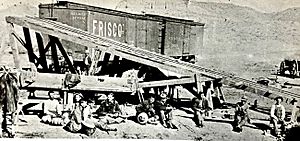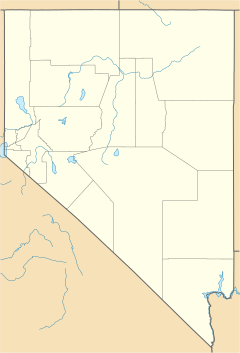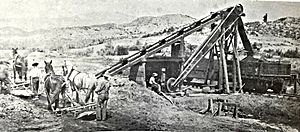Bullionville, Nevada facts for kids
Quick facts for kids
Bullionville, Nevada
|
|
|---|---|

Bullionville, c 1875
|
|
| Country | United States |
| State | Nevada |
| County | Lincoln |
| Elevation | 4,760 ft (1,451 m) |
Bullionville is a ghost town in Lincoln County, Nevada, United States. A ghost town is a place where people used to live and work, but now it's empty. Bullionville is located near the towns of Panaca and Pioche. This town was busy from about 1870 to 1882, but today, no one lives there.
Contents
How Bullionville Began
Bullionville was started in February 1870. It became a town because a special machine called a "five-stamp mill" was moved there. A stamp mill was used to crush rocks to get valuable metals like gold and silver.
The people who built the town chose this spot because it had a good supply of water from Meadow Valley Creek. Water was very important for running the mills. At first, the camp was called Ely City, but it was soon renamed Bullionville.
Building the Mills
From 1870 to 1872, many mills from a nearby town called Pioche were built in Bullionville. This was because Bullionville had plenty of water, which Pioche didn't have enough of for its mills.
To move the crushed rock (called ore) from the mines to the mills, a special train track was built. This was a "narrow gauge railroad," which means the tracks were closer together than regular train tracks. The 21-mile long Pioche and Bullionville Railroad started moving ore by 1873.
Life in Bullionville
Bullionville grew very quickly between 1872 and 1875. At its busiest, about 500 people lived there. The town had many things people needed, like:
- Hotels for travelers
- Stores to buy supplies
- Several saloons (places where adults could drink)
- Blacksmith shops to fix tools and make metal items
There was also a stagecoach service that ran daily to Pioche. This helped people travel and send mail. In April 1874, Bullionville even got its own post office.
Water for Pioche
In 1875, a water system was built to carry water from Bullionville to Pioche. This helped Pioche's mills get the water they needed to process ore.
Why Bullionville Became a Ghost Town
After 1875, Bullionville slowly started to decline. The mills that were so important to the town began to be moved away between 1875 and 1877. This meant less work and fewer reasons for people to stay.
By 1880, the railroad between Pioche and Bullionville stopped running. Without the mills and the railroad, the town became empty. The post office closed in November 1886. It reopened for a short time in October 1892 but closed again for good in July 1898.
Today, there are no original buildings left to show where Bullionville once stood. It is truly a ghost town, a reminder of Nevada's mining past.




